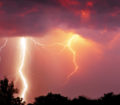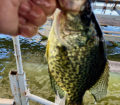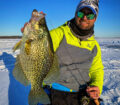By Steve Weisman
Over the years, I have watched fishing regulations change as fisheries biologists have worked to improve our fisheries. Here on the Iowa Great Lakes, we have worked with length limits and now slot limits to maximize walleye brood stock and improve recruitment into angler catchable fish.
The same holds true for bass with a 15” length minimum and promoting the catch-and-release philosophy. We now have trophy bass and definitely outstanding numbers.
At the same time, panfish daily limits have been moved so that the limit is 25 for perch, crappies and bluegills. Before this was done and when the bite was really on, I watched 5 and 6 gallon buckets of big crappies and bluegills taken out of the lake.
Over the years, I’ve often wondered why we work so hard on fish like walleyes and bass to protect size and improve the overall catchable sizes; yet we do not address that with panfish, especially bluegills. Nothing beats catching those big male bluegills. However, these large males (bulls) are the key to keeping quality size up.
Certainly, there are a lot more bluegills in a lake than there are walleyes and bass. They are extremely prolific, and when you take a lake like West Okoboji with its structure and habitat, bluegills have a better chance to keep their size than in other lakes with less structure and habitat.
I mean look at what West Okoboji has to offer: bays with lots of emergent vegetation, plenty of epiphytic macroinvertebrates (which are basically bugs on plants) along with some good quality submerged vegetation, which provides cover and protection, as well as food for the young of the year. Plus, weedlines will occur in depths up to 20+ feet, and there are many opportunities for bluegills to suspend over incredibly deep water. These lake qualities give bluegills a good chance to avoid predators and to also gorge themselves with food.
Still, I am concerned that the overall size of our bluegill population is diminishing. Over the past few years, I have found myself catching fewer big bulls and females in that 9½ to 10-inch range. This past winter most everything seemed to be in the 7½ to 8-inch range. Lots and lots of them that size, but very few of the really big gills.
Now, maybe it’s just a coincidence or a glitch in the cycle, and maybe the big fish will just naturally return. However, I wonder. So, I decided to research neighboring states and also our own state. To see what other states are doing, I researched the topic “protecting big bluegills” and found that the Minnesota DNR and the Wisconsin DNR has found this to be a problem in their state. They have found that having reduced bag limits on some of their fisheries have had a positive impact on the overall size structure of bluegills in the lake.
Of course, during the spawning season, the big males are the most vulnerable. They are the protectors of the nesting area. Without their presence, the bluegill population is more likely to get smaller overall. Once they are removed, it allows smaller fish to spawn and become sexually mature. This is why it’s vitally important to release these particular fish back into the lake because their presence ultimately determines the overall size structure of the population.
Iowa DNR’s perspective
The Iowa DNR has also looked at factors that improve bluegill size structure and population health. Bluegill populations from lakes across the state have been examined and surprisingly it has been found that lakes experiencing some the highest levels of bluegill harvest actually have had the best and healthiest populations. This seems a bit counter intuitive but conclusions from this study indicate that protecting and improving habitat and water quality were the most important keys to protecting the bluegill populations and that bluegill harvest had little impact.
Mike Hawkins, fisheries biologist with the Iowa DNR, suggests that the level of harvest, especially in our large lakes, is overwhelmed by other factors influencing these populations. Hawkins says, “These other factors include recruitment, predator populations, size structure and other environmental conditions.” He goes on to say, “Changes in bluegill size structure from harvest by anglers may indeed occur in isolated areas, but those impacts are short lived. Bluegill populations respond to harvest positively with increased growth and increased reproduction. Unlike longer living and less numerous predators that benefit from harvest protection in certain instances, short-lived bluegills and other panfish species are rarely negatively impacted by harvest in our productive waters.”
This is certainly a complex issue with a wide range of factors that influence bluegill fisheries. At this point here in Iowa, until other data is collected, things will stay the same. There seems to be a push by some angler groups to provide more catch and release of larger bluegills. If anglers choose to do so, as always, that is their choice. As for me, I will probably do some volunteer catch-and-release of the big bluegills, especially the males during the critical spawning time.
My goal this year is to catch some of those big ones when I can, but then return most of them and bring home the medium size bluegills for a meal. If it’s just two of us for a meal, I will most likely keep up to 10-12 bluegills. I can catch as many as I want and return them safely back to the lake.
We’ll see if this makes a difference or not.















